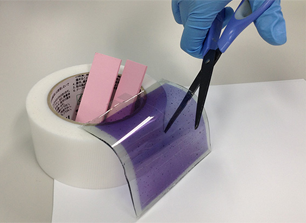These displays can be cut with a pair of scissors into different shapes
A team of Japanese researchers has developed new display sheets that can be cut into any shape with a pair of scissors so that they can be attached to other surfaces like clothing and buildings.
The research group led by Masayoshi Higuchi, head of the Electronic Functional Macromolecules Group, Research Center for Functional Materials at National Institute for Materials Science used a polymer with electrochromic properties (organic/metal hybrid polymer) to create the display. This polymer can be sprayed onto a flexible substrate to form a coating layer that’s stable when in contact with moisture and oxygen. The new display requires only a few seconds of electrical input to switch visual information and will last even after power supply stops.

Most of the devices we use today employ some sort of common display like a LCD or OEL, but there’s also a growing demand for displays that can be used in other, less common places like digital signage and wearable devices. Since it’s impossible to cut these conventional displays into various shapes to fit different needs because the contents of both LCDs and OELs needs to be sealed and since these displays require continuous power supply to maintain their functions, it was challenging for the team to develop a display that could actually be cut while using existing technologies.
In the future, the team will work to increase the display area and make it capable of showing multiple colors.
“We also intend to propose a concept called ‘new life style’ in which people can enjoy changeable colors in everything,” wrote the team.
Potential applications for the new technology include a society where users can change the colors of various objects and items, such as windows, car interiors, umbrellas, or sunglasses, as well as display letters and symbols.
This study was conducted under the project: “Ultrafast, ultralow-power, ultralarge-area electrochromism.”
Learn more at NISM.


Comments are closed, but trackbacks and pingbacks are open.